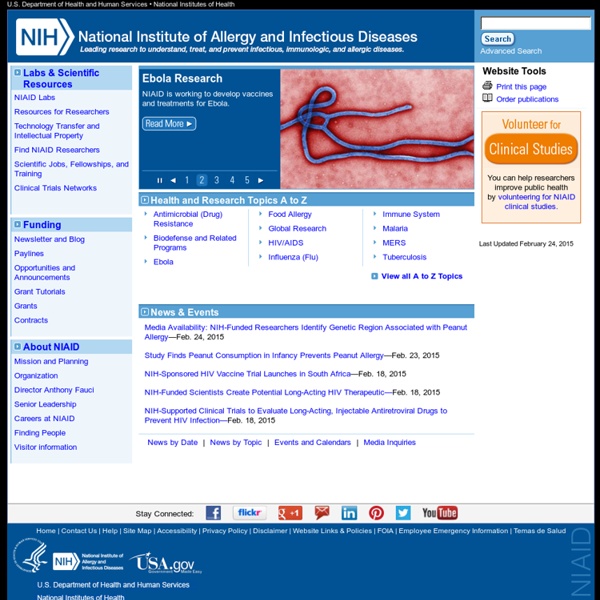



http://www.niaid.nih.gov/Pages/default.aspx
Related: Disease understandingCeliac Disease Foundation Division of Parasitic Diseases - Schistosomiasis Fact Sheet BaylisascariasisRaccoons more active in spring...Learn More» Animated VideoNPR's history of resistance to malaria drugs (2.5 Minutes).Learn More» CDC Bottle BioassayCDC Bottle Bioassay Manual Now Available OnlineLearn More» A parasite is an organism that lives on or in a host and gets its food from or at the expense of its host. Parasites can cause disease in humans. Some parasitic diseases are easily treated and some are not. The burden of these diseases often rests on communities in the tropics and subtropics, but parasitic infections also affect people in developed countries.
Trigger Point and Referred Pain Guide Pan American Health Organization Health Financing and Economics AnnouncementsOther Resources Periodical Publications Announcements THE GLOBAL ECONOMIC RECESSION and the MILLENNIUM DEVELOPMENT GOALS Washington, D.C. 49th Directing Council. October 1, 2009.- Important dialogue between Ministers of Health of the Americas during the celebration of the 49º.Directing council of PAHO analyzes the impact of the world economic crisis for the achievement of the Millennium Development Goals, the most ambitious endeavor ever pursued against poverty, where the principles of equity, solidarity and the right to the highest attainable health are the core values of the PHC approach; while its guiding principles are the responsiveness to people's health needs, social justice, quality-oriented services, government accountability, sustainability, participation and intersectoriality.
THE MERCK MANUAL MEDICAL LIBRARY: The Merck Manual of Medical Information--Home Edition School, Boards and Balance April 8th 2014 Dustin There are less than two weeks left in my second year here at UCLA. This year has really flown by. I have found it fairly easy to focus on my schoolwork during this year and tune boards out. Foodborne Illness Costs U.S. $152 Billion Annually, Landmark Report Estimates Welcome to the Pew News Room. We regularly update this section with the latest news about our work. We apply a rigorous, analytical approach to improving public policy, informing the public and stimulating civic life. Based in Philadelphia and Washington, D.C., Pew produces fact-based research and develops practical solutions to challenging issues.
Do a Total Background Check on Yourself - Annual Consumer Reporting Agencies The Federal laws FCRA and FACTA, which govern the credit bureaus Experian, Equifax, and TransUnion, also regulate a whole universe of other corporations known as “nationwide specialty consumer reporting agencies” and include such companies as: ChoicePoint, Acxiom, CBC Innovis, PayChex, the Insurance Services Office (ISO), Tenant Data Services, LexisNexis, Retail Equation, Central Credit, TeleTrack, the Medical Information Bureau Inc. (MIB), Ingenix Inc., and Milliman Inc. In fact, just as financial companies rely on “credit reports” to establish credit for customers, insurance, real estate, banking, and retail companies also utilize credit report files to assess consumers and charge higher prices.
Flu.gov
National Institute of Allergy and Infectious Diseases (NIAID) est une agence fédérale nord-américaine, département du National Institute of Health, organisme fédéral que l'on peut assimiler au ministère de la santé. Le NIAID est responsable de la recherche biomédicale nord-américaine dans le domaine des maladies infectieuses et des affections allergiques. Source: by epc Sep 3